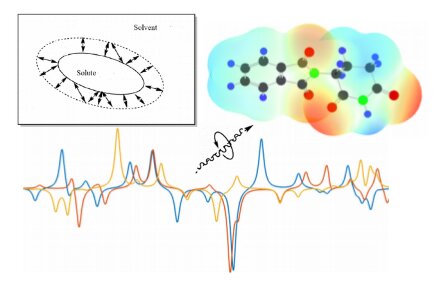Solvent Effects in Vibrational Spectra

A large amount of the molecules from which living beings consist of are chiral, e.g. amino acids, sugars and a large portion of terpenes and hormones, to name but a few. Differential interactions between chiral compounds and a chiral receptors give rise to stereoselective biological processes, invoking different responses of organisms to the enantiomers (and diastereomers). Consequently, a reliable determination of the absolute configuration of compounds is essential and in high demand. As the bulk of the active ingredients of newly developed drugs contain chiral centers, regulatory agencies have been demanding both enantiomers of the chiral compounds to be tested individually in their therapeutic effects and side-effects. Moreover, as pure enantiomers can provide higher degrees of selectivity towards receptors, their use and importance will only keep on increasing along with the demand for more reliable methods to assign absolute configurations.
Recently, vibrational circular dichroism (VCD) spectroscopy has been established as the most versatile method available for performing these determinations. This technique measures the differential absorption of left and rights circularly polarized light in the infrared region of a solution of the chiral compound. The connection between its absolute configuration and the experimental VCD spectrum is established through matching a quantum chemical prediction of the VCD spectrum for a given configuration with the experimental spectrum. Unfortunately, because many substances do not dissolve in desirable concentration or aggregate in apolar solvents, and by consequence spectra of solutions in a polar solvent have to be used instead, the limits of VCD are reached when studying molecules with multiple conformers capable of forming strong intermolecular interactions, as the predictions become less reliable in these instances.
To overcome these limitations, we are developing a novel and more robust approach that can be used to quantitatively address the influence of solvent molecules on the IR and VCD spectra of solute molecules.